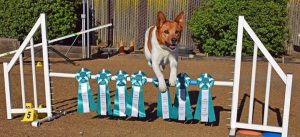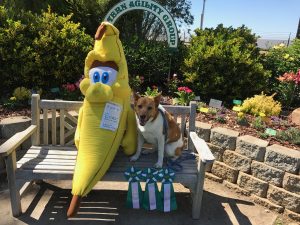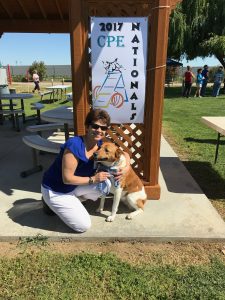After settling my dog, Bailey, in a sit-stay in front of the first agility jump, I stepped toward the second numbered obstacle—the dreaded “scary teeter.” This standard agility course at the Canine Performance Evaluation (CPE) Nationals Competition in Elk Grove, California promised to be one of the most difficult events. I reviewed my handling moves: Lead out pivot, shape the teeter entry, power to the tunnel, twist shoulders away from off-course tunnel, then decelerate to nail the weave pole entry. I inhaled and I sent a silent plea to my dog: please, please, please, don’t stop to bark at the judge.

Bailey was an unlikely candidate to compete at Nationals. Although I adopted this Australian Shepherd/Queensland heeler mix as a puppy, her early interactions with men had not gone well. Her litter had been rescued from a Central Valley farmer who’d planned to abandon the puppies out in the fields as coyote food, so I suppose her misgivings are justified. Bailey’s “stranger-danger” motivated me to start her in agility training at Frielance Dog Sports in 2012. Though she’s grown more confident on the equipment over the years, her distrust of men still lingers. My worst fear at Nationals was that she’d abandon the course to bark at the judge with raised hackles.
My nerves stretched taut as violin strings as I gave Bailey the release command. I wasn’t feeling confident about achieving a qualifying score, which entails completing all numbered obstacles in sequence, within a set time, accumulating a sufficient number of points, and avoiding too many penalties from mistakes such as knocking a bar off a jump or taking an obstacle out of order. An amazing feat that the dog must accomplish without food or toy incentives. This 18-obstacle course required the dog to complete not one, but two teeters, where the dog must run up a slanted board, use their front legs and body weight to tip the ramp, then descend to the ground. This obstacle has been Bailey’s downfall asking her to complete two in less than a minute seemed impossible. Yet she completed the first teeter without hesitation, took the appropriate jumps and tunnels, then navigated through twelve vertical weave poles, and traversed a dog walk that stood 4 ½ feet off of the ground. Still, the second teeter loomed large at the end of the course.
Agility requires precision teamwork. The sport has multiple venues where dog and handler can compete. Each organization offering competitive events with a set of specific rules. I compete in Canine Performance Evaluations (CPE) which has a multitude of events. To compete at Nationals Bailey had to be entered in all events which included 2 Standard, 2 Jackpot, plus Jumpers, Fullhouse, Colors, Wildcard and Snooker courses. Fullhouse was our first event (see video). The rules require the dog to accumulate 25 points within 30 seconds and jump onto a table within 5 seconds of the whistle. More difficult obstacles, such as the A-frame are worth 5 points, tunnels are 3 points and single jumps are 1 point and you must include 3 one-point, 2 three-point and 1 five point obstacle in your run. Bailey performed like a pro and got the jitters out.

Owners have their own learning curve. The dog handler must memorize the course of up to twenty obstacles and guide the dog successfully through it. Because dogs respond to body language and make split second decisions about the next obstacle to take, the human teammate must be aware of the direction of their feet even as they are giving verbal commands. When executed well, agility is a dance of exquisite beauty between a dog and its handler.


Typically, it takes a minimum of one year to train a dog in the skills to compete in agility. Bailey was right on track. But even as her confidence on the equipment grew, her fear of judges never waned. So, never in a million years did I imagine that Bailey and I could participate at the nationals level—a journey that started over twelve months ago. To compete in the 2017 CPE Nationals, a dog must have achieved 30 qualifying scores during CPE agility trials over the 2016 calendar year.
My main national’s goal was to have fun with my dog, a principle Linda Eickholdt, president of CPE, reiterated at Nationals. According to Eickholdt, “The 2017 Nationals was comprised of 70 to 75% first time competitors. But because even seasoned handlers tend to be more nervous at Nationals, she emphasizes at the morning briefings each day that owners should relax and enjoy the time with their dogs.”
After avoiding a tunnel-jump discrimination trap, Bailey and I were on the home stretch—one more scary teeter and a final jump. Bailey had other plans and ran past the teeter, but then came back and tipped the board like a pro. She took the final jump and we’d qualified in this challenging standard course along with 57 out of 117 Level 5 canines.

After completing the nine runs over the three day Nationals event, Bailey had qualified in seven out of nine runs. Competing at Nationals deepened the bond between me and my precious pup. My dog may never fully enjoy the teeter obstacle and she may always be distrustful of men, but her enthusiasm for the sport of agility was apparent as she scaled jumps and rocketed through tunnels. And Bailey never once barked at the three male judges residing over the Nationals event—an accomplishment way more important than ribbons.





















